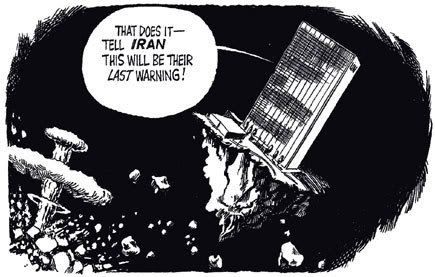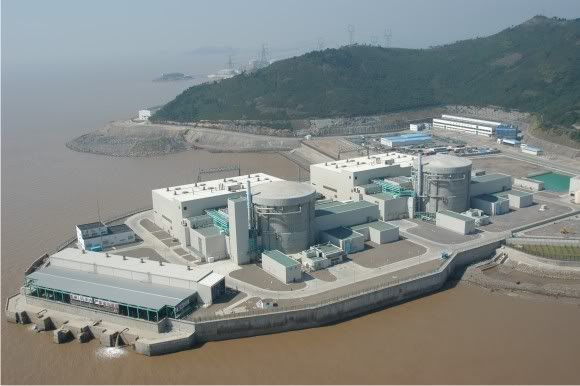Iran to increase uranium enrichment by ten times
Posted: Thu Feb 26, 2009 6:01 pm
Iran denies nuclear slowdown, sets big expansion
Wed Feb 25, 2009 9:45pm EST
By Hossein Jaseb
BUSHEHR, Iran (Reuters) - Iran said on Wednesday it plans a nearly 10-fold expansion of its uranium enrichment capacity in the next five years, denying a U.N. report which said its nuclear activities had slowed.
"Our plans to install and run centrifuges is not based on political conditions ... We have neither slowed down or accelerated our work there," Gholamreza Aghazadeh, head of the Atomic Energy Organization of Iran, told a news conference.
He was speaking in southwestern coastal town of Bushehr where Iran is building its first nuclear power plant. Iran said on Wednesday it had carried out successful tests at the Russian-built plant, taking it a step closer to its launch.
The visiting head of Russia's state nuclear company, Sergei Kiriyenko, hailed "significant improvements" in the Islamic Republic's first such plant to produce electricity.
Aghazadeh said Iran would over the next five years install 50,000 centrifuges used to enrich uranium at its Natanz plant in the central desert, up from the 6,000 he said were now running.
"We will increase our activities to install more by the end of next (Iranian) year (to March 2010)," he said.
He did not specify whether all 6,000 were enriching uranium. Iran was feeding uranium into just under 4,000 as of February 1 but had another 1,600 installed with most being tested at the time, the International Atomic Energy Agency said last week.
The latest IAEA report showed Iran had added few centrifuges to production since August in what U.N. officials assessed to be a "considerable" slowdown in the expansion of the program.
But the report also showed a notable buildup in Iran's stock of enriched uranium, in theory giving it enough to convert into fuel for one atom bomb if it so chose. But this would require a raft of technical steps taking two or more years, experts say.
The West accuses Iran of covertly seeking to build nuclear weapons, something Tehran denies, insisting its activities are aimed at generating electricity to meet soaring demand in the world's fourth largest oil producer.
Last week IAEA head Mohamed ElBaradei said the reason for the perceived slowdown may have been political -- to keep open the chance of talks with U.S. President Barack Obama's new administration -- rather than caused by technical issues.
Obama has said the United States is prepared to talk to Tehran, in a break from his predecessor's approach, but his administration has also warned of tougher sanctions if Iran continues to defy U.N. demands to suspend enrichment.
"FACE REALITY, AMERICA"
"America should face reality and accept living with a nuclear Iran. This acceptance will allow America better access to Iran's (nuclear) market," Aghazadeh said, adding that a fresh nuclear achievement would be announced on April 9.
He did not give details.
A Western security source in Europe told Reuters there were indications Tehran would proclaim on its annual nuclear festival day in April a breakthrough in running advanced-model centrifuges and their introduction in large numbers to the underground Natanz enrichment hall.
He said Iran appeared to have overcome technical problems that may have delayed deployment of advanced-generation centrifuges in production lines for over a year.
Up to now, Iran has been enriching with only a fragile, inefficient 1970s vintage machine known as the P-1, adapted from a model obtained from former Pakistani-run nuclear smugglers.
Diplomats said Iran told the IAEA this week that it had begun testing an IR-4 model of centrifuge, a possible step up on IR-2s and IR-3s under testing for months, at a pilot plant.
Advanced models would enrich 2-3 times as fast as the P-1 and be much more durable, nuclear analysts say.
Western analysts say Iran has in the past exaggerated progress to boost its bargaining position with world powers.
The West has been cool to Russia's involvement in building Bushehr. Russia says the plant cannot be used for any weapons program since Iran will return all spent fuel rods to Russia.
Iran said tests had been conducted to inject "virtual" fuel into rods, using lead, not enriched uranium, over some 10 days.
Worries that Russia would not complete Bushehr for political reasons had now been removed, Aghazadeh told state television.
He said further tests would be carried out in coming months. No date was given for the reactor's start-up. "I cannot give you a date. But as soon as all tests are successfully carried out the plant will be launched," Kiriyenko said.
The launch of Bushehr has been delayed frequently. Russia last year completed delivery of nuclear fuel to the station under a contract estimated to be worth about $1 billion.
(Additional reporting by Parisa Hafezi in Tehran and Mark Heinrich in Vienna; Writing by Edmund Blair; Editing by Dominic Evans)
© Thomson Reuters 2008. All rights reserved. Users may download and print extracts of content from this website for their own personal and non-commercial use only. Republication or redistribution of Thomson Reuters content, including by framing or similar means, is expressly prohibited without the prior written consent of Thomson Reuters. Thomson Reuters and its logo are registered trademarks or trademarks of the Thomson Reuters group of companies around the world.

